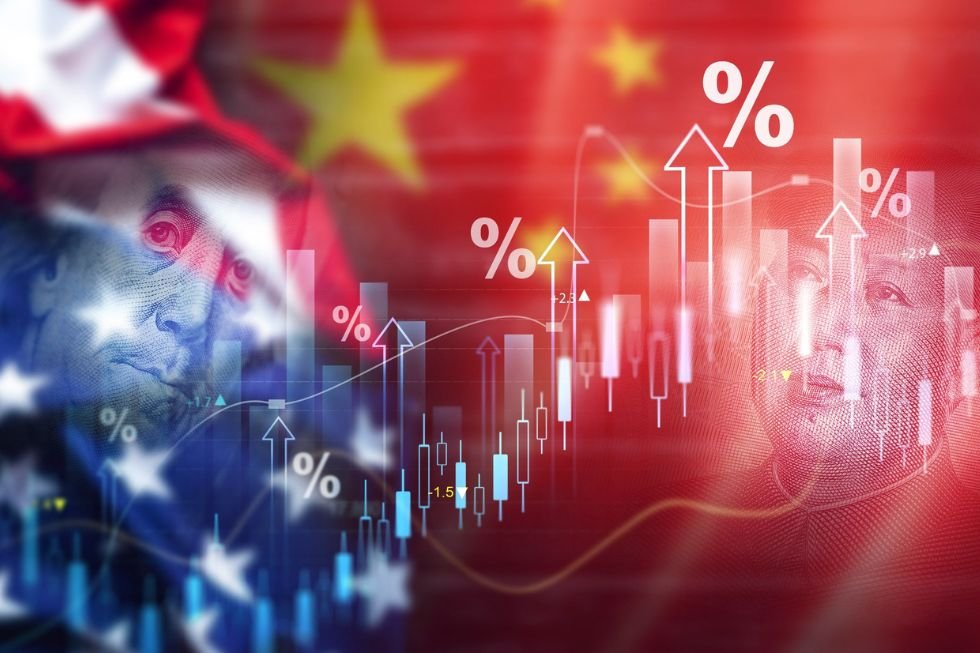Tariffs are traditionally seen as instruments of strategic economic policy — tools for protecting domestic industries, exerting pressure on rivals or shaping global trade norms. Yet under US President Donald Trump, their erratic deployment has served less as a coherent tool of statecraft and more as a symbol of strategic disorientation. Nowhere is this misapplication more consequential than in the US–China rivalry, where ad hoc protectionism yields geopolitical costs, empowered adversaries and confused allies.
Resilient exports, shifting leverage
According to The Wall Street Journal, China’s July 2025 trade data underscores a structural paradox in the US–China economic confrontation. Even under the highest effective US tariff rates since the 1930s — averaging about 18% across imports — Beijing’s total exports grew 7.2% year-on-year, up from 5.8% in June. While shipments to the United States fell 22% over the same period, surging sales to other regions more than compensated for this shortfall. The pattern reflects more than opportunistic market redirection; it signals a deeper, long-term recalibration of China’s global supply chain positioning in response to sustained US trade pressure. Thanks to this shift, Beijing has embedded its manufacturing base more firmly into the economies of emerging markets, insulating export volumes from US market fluctuations.
The endurance of China’s export growth reveals the limitations of tariffs applied without an
integrated, capacity-based strategic framework. Intended to prompt reshoring and erode Chinese manufacturing dominance, the measures instead catalyzed adaptive behaviors: forging new trade corridors, exploiting transshipment hubs, leveraging industrial overcapacity to sustain competitive pricing and accelerating domestic substitution in critical technologies. The more tariffs are linked to ad hoc geopolitical bargaining, such as conditioning relief on reduced Chinese support for Russia, the further they drift from being credible instruments of long-term industrial policy.
July’s figures highlight that Beijing’s capacity to synchronize trade strategy with diplomatic leverage remains intact. Without a coordinated, ally-driven approach combining market access strategy, technology standard-setting and industrial alignment, Washington’s episodic tariff escalations will likely fail to meaningfully redirect China’s strategic trajectory.
China’s adaptive response and industrial realignment
China’s reaction to the US tariff regime has been both resilient and strategically adaptive. Far from undermining the Chinese Communist Party (CPC), tariffs handed Beijing a propaganda victory. They have reinforced Chinese President Xi Jinping’s narrative of “great changes unseen in a century” and irked governments in the Global South that are disillusioned with Western-dominated globalization.
Beijing does not seek full economic decoupling, but it has prepared for that possibility. Tech giants like Huawei, ByteDance and ZTE have accelerated diversification away from US technology and markets. These moves have catalyzed a more autonomous industrial and technological base.
Though US tariffs inflicted real pain, especially in low-margin manufacturing, this disruption served CPC objectives: It hastened industrial upgrading, eliminated inefficiencies and advanced China’s climb up the value chain. Politically, the CPC remains insulated from unemployment shocks. This resilience is rooted in precedent; between 1994 and 2006, China absorbed the displacement of over 73 million workers during market reforms without destabilizing the regime.
Capacity building and enduring strategic gains
In strategic terms, the longer-term consequences of the US tariff approach are far more significant than short-term trade disruptions. Like the technology sanctions targeting Huawei, ByteDance and ZTE, the tariff regime has pushed Beijing to double down on indigenous innovation. China’s 14th Five-Year Plan prioritizes self-reliance in semiconductors, artificial intelligence and advanced manufacturing — critical domains in the global contest for economic and military primacy.
China’s structural weaknesses, especially its low household consumption rate, impede full economic rebalancing. But its commitment to techno-industrial advancement is already delivering results. In quantum communication, hypersonic systems and naval power projection, it has made notable gains. In maritime strength, its navy is already the world’s largest by vessel count; it is projected to further increase by 395 ships by the end of 2025 and 435 ships by 2030, outpacing the US Navy’s fleet of around 300. In missile technology, China leads the deployment of conventional and anti-ship ballistic systems. In aerospace, it now produces over 100 fourth-generation fighter jets annually and has broken through key bottlenecks, such as domestic jet engine production.
These advances are not ephemeral. Once a strategic scale is built, it tends to persist. China’s industrial and military base, now the product of two decades of accelerated capacity-building, constitutes a foundation for sustained competition, even if its macroeconomic performance falters.
The US response
Despite post-pandemic growth and a dynamic tech sector, the US risks falling into a familiar trap: strategic complacency. The country today underestimates the scale and momentum of China’s challenge. It assumes that demographic constraints and economic inefficiencies will naturally blunt Beijing’s geopolitical trajectory. This is wishful thinking.
Measured by strategic metrics, including manufacturing output, patent filings, AI deployments and defense-industrial throughput, China is either leading or rapidly converging. At purchasing power parity, its economy is already 25% larger than that of the US. It leads the world in the production of steel, cement, electric vehicles and energy — hard capacity that translates into sustained geopolitical leverage.
Tariffs alone cannot reverse this. Worse, if applied unilaterally or inconsistently, they risk reinforcing the very strategic autonomy that the US seeks to preclude. A recalibrated approach must begin with a recognition that scale, not just control, is the new currency of great-power competition.
A coalition of capacity
The imperative now is not to counter China unilaterally, but to build and sustain an allied industrial-technological coalition capable of competing at scale and speed. US alliances are no longer platforms for power projection — they are instruments for power preservation. Strategically, America cannot compete without its allies, nor should it try.
Consider the arithmetic of a coalition. A grouping of like-minded economies — the US, European Union, Japan, India, South Korea, Australia, Canada, Mexico and New Zealand — commands over $60 trillion in GDP at market exchange rates, more than triple China’s $18 trillion. At a purchasing power parity, this bloc still outpaces China by a factor of two. It produces nearly half the world’s manufacturing output, accounts for a majority of active patents and scientific citations and spends nearly $1.5 trillion annually on defense — more than twice China’s budget.
But these advantages are latent unless activated through integration. Strategic scale must be realized through shared systems: interoperable defense industries, harmonized industrial policies, joint technological development and coordinated trade regimes. This requires a fundamental shift in the logic of US statecraft — from hierarchical alliance management to coequal capacity generation.
The cost of strategic misjudgment
The Trump administration’s unilateralism stands in stark contrast to this policy approach. Its use of the 1977 International Emergency Economic Powers Act to justify tariffs on allies, including Japan and the EU, exemplified strategic incoherence. According to the Council on Foreign Relations report, Trump claimed that foreign capital inflows — $550 billion from Japan, $600 billion from the EU — were a triumph of his tariff policies. Yet by definition, capital inflows widen the US current account deficit, the very “emergency” cited as justification for the tariffs.
If even half of these claims were true, the resulting $1.15 trillion in new investment would mechanically worsen the US current account by over $500 billion over three and a half years. The contradiction underscores a deeper problem: a misunderstanding of macroeconomic dynamics and a misapplication of economic instruments in pursuit of strategic ends.
From gesture to grand strategy
Strategic competition with China demands more than punitive tariffs and rhetorical bravado. It requires scale, coordination and coherence. These attributes cannot be summoned by unilateral action. They must be built deliberately, patiently and multilaterally.
The future of American strategy is best served by moving beyond Cold War approaches or past trade disputes and instead developing a modern framework for collective capacity. By working in close partnership across industrial, technological and military domains, the US and its allies can maintain a competitive edge in the 21st century. Without such collaboration, sustaining long-term strategic advantages will prove far more difficult.
[Lee Thompson-Kolar edited this piece.]
The views expressed in this article are the author’s own and do not necessarily reflect Fair Observer’s editorial policy.
Support Fair Observer
We rely on your support for our independence, diversity and quality.
For more than 10 years, Fair Observer has been free, fair and independent. No billionaire owns us, no advertisers control us. We are a reader-supported nonprofit. Unlike many other publications, we keep our content free for readers regardless of where they live or whether they can afford to pay. We have no paywalls and no ads.
In the post-truth era of fake news, echo chambers and filter bubbles, we publish a plurality of perspectives from around the world. Anyone can publish with us, but everyone goes through a rigorous editorial process. So, you get fact-checked, well-reasoned content instead of noise.
We publish 3,000+ voices from 90+ countries. We also conduct education and training programs
on subjects ranging from digital media and journalism to writing and critical thinking. This
doesn’t come cheap. Servers, editors, trainers and web developers cost
money.
Please consider supporting us on a regular basis as a recurring donor or a
sustaining member.
Will you support FO’s journalism?
We rely on your support for our independence, diversity and quality.









Comment